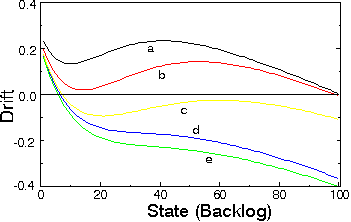
Drift of backlog of ALOHA network
Finite population of 100 terminals

Figure:
Drift for a network of 100 users for a receiver without capture (a), and for a receiver with threshold of 6 dB (z = 4) for
- a channel Rayleigh fading only (b),
- shadowing (6 dB) and Rayleigh fading (c),
- near-far effect and Rayleigh fading (d),
- near-far effect, 6 dB shadowing and Rayleigh fading (e).
The system most likely is near a point where the drift crosses zero in negative direction.
- for states slightly higher, the system moves to a lower state
- for states slightly lower, the system moves to a higher state
In this case all zero-crossings are with negative derivative.
Moreover, each curve happens to cross zero only once. None of the systems is bi-stable.
Further discussion
If capture never occurs in the presence of other packets (curve a), entire saturation (expected state is all terminals in backlog) leads to extraordinarily high delay. For the traffic parameters studied here, network performance is not essentially improved by Rayleigh fading only, e.g. if adaptive power control is applied to compensate slow power variations: steady-state operation is found at a backlog of nearly 100 terminals. Detailed computations revealed that the average delay is about 7000 slots. For Rayleigh fading combined with shadowing or near-far effects a single equilibrium occurs, with low average delay in the order of 10 to 15 time slots. Even if the near-far effect is ignored, i.e., all terminals are located at an identical distance from the central receivers, as in curve (c), the network is stable and terminals experience little backlog. Therefore, it may be concluded that for the reported traffic parameters, the stability of the network does not rely on terminals unrealistically close to the base station.
Back to drifts





